
The quick liquidity ratio is an important measure of an insurance company’s ability to cover its liabilities with relatively liquid assets. The financial metric does not give any indication about a company’s future cash flow activity. Though a company may be sitting on $1 million today, the company may not be selling a profitable good and may struggle to maintain its cash balance in the future.
Robeco Institutional Asset Management B.V. Reduces Stake in TE … – Best Stocks
Robeco Institutional Asset Management B.V. Reduces Stake in TE ….
Posted: Thu, 03 Aug 2023 21:05:28 GMT [source]
For example, a company with a very high quick ratio may be holding too much cash on its balance sheet, which could be put to better use. A high quick ratio is an indication that a company is utilizing its short-term assets effectively to meet its financial needs. Therefore, it is important to use quick ratios and other financial ratios and analysis tools to get a complete picture of a company’s performance. It also helps investors and creditors assess the risk and profitability of a company. Generally speaking, a quick ratio between 1 and 2 is considered healthy for most businesses. Calculating the quick ratio for your business to ensure it has enough liquidity to operate is worthwhile.
A company with a low quick liquidity ratio that finds itself with a sudden increase in liabilities may have to sell off long-term assets or borrow money. Quick assets are integral to a company’s liquidity and indicate short-term financial health. Companies maintain quick assets per the requirement and industry in which they operate. Business managers should balance holding an appropriate level of quick assets to avoid sacrificing much on opportunity cost.
Quick Links
However, the quick ratio doesn’t factor in these payment terms, so it may overstate or understate a company’s real liquidity position. In addition, the quick ratio doesn’t take into account a company’s credit facilities, which can significantly affect its liquidity. The quick ratio measures a company’s ability to raise cash quickly when needed. For business managers, it’s one of a suite of liquidity measures they can use to guide business decisions, often with help from their accounting partner. The quick ratio also doesn’t include prepaid expenses, which, though short-term assets, can’t be readily converted into cash.

However, please note that the content provided on our website is for informational and educational purposes only, and should not be considered as professional financial or legal advice. If you require such advice, we recommend consulting a licensed financial or tax advisor. Publicly traded companies generally report the quick ratio figure under the “Liquidity/Financial Health” heading in the “Key Ratios” section of their quarterly reports. However, to maintain precision in the calculation, one should consider only the amount to be actually received in 90 days or less under normal terms. Early liquidation or premature withdrawal of assets like interest-bearing securities may lead to penalties or discounted book value. Differs from an accounts receivable loan in that a company sells its receivable invoices to another company (called a factor) outright.
That’s why the quick ratio excludes inventory because they take time to liquidate. Current liabilities are a company’s short-term debts due within one year or one operating cycle. Accounts payable is one of the most common current liabilities in a company’s balance sheet. It can also include short-term debt, dividends owed, notes payable, and income taxes outstanding.
Free Financial Statements Cheat Sheet
The adjusted quick ratio computes to 1.6 using the formula (10, ,000) / 5,000.Current liabilities are outweighed by current assets (not including inventory) by $1.6 for every $1, thanks to the company. A company with more of these assets than current liabilities is considered to have a strong liquidity position, which means it can pay its bills on time and avoid financial distress. Liquidity can be measured by determining the current ratio, calculated as the division of current assets by current liabilities.

That ultimately means quick liquidity ratios and current ratios can differ significantly. For instance, a company stocking lots of inventory could have a high current ratio and low quick liquidity ratio. Like the quick liquidity ratio, the current ratio also measures a company’s short-term liquidity, or ability to generate enough cash to pay off all debts should they become due at once. The quick liquidity ratio is deemed to be more conservative than the current ratio, though, because it takes fewer assets into consideration. Companies tend to use quick assets to cover short-term liabilities as they come up, so rapid conversion into cash (high liquidity) is critical. Inventories and prepaid expenses are not quick assets because they can be difficult to convert to cash, and deep discounts are sometimes needed to do so.
Limitations of Quick Ratio
While there are some limitations to the use of quick assets, they remain a critical part of evaluating a company’s financial health. Quick assets include cash, cash equivalents, and accounts receivable that can be converted into cash quickly, typically within 90 days or less. These assets are considered part of a company’s current assets, and they play a critical role in assessing the company’s ability to meet short-term financial obligations. Quick assets are assets owned by a company that has a commercial or exchange value and can be easily converted to cash or are already in cash form.

Quick assets are always current as they can convert to cash in a year or less. But sometimes companies keep some of their assets in an alternate form of cash that cannot easily cash out. Current assets are short-term investments that you can convert to cash in a year or less. The “quick” part of quick assets refers to how quickly or easily they can turn them into cash. The term quick assets is often used interchangeably with the term current assets.
Automate and accelerate your Amazon QuickSight asset deployments using the new APIs
Quick assets typically include cash, cash equivalents, and accounts receivable. By understanding quick assets, businesses can efficiently manage their financial resources and make informed decisions regarding their liquidity position. Quick assets refer to assets owned by a company with a commercial or exchange value that can easily be converted into cash or that are already in a cash form.
- As a result, they are considered to be the most liquid assets held by a company.
- Liquid assets are those that can quickly and easily be converted into cash in order to pay those bills.
- Though other liquidity ratios measure a company’s ability to be solvent in the short-term, the quick ratio is among the most aggressive in deciding short-term liquidity capabilities.
- The quick ratio measures a company’s ability to raise cash quickly when needed.
Quick assets are more liquid than current assets as they do not include inventory and prepaid expenses. Quick assets are those assets that can be easily converted into cash within 90 days or less. Current assets are those assets that can be converted into cash in more than 90 days but within one year. The quick ratio is the barometer of a company’s capability and inability to pay its current obligations. Investors, suppliers, and lenders are more interested to know if a business has more than enough cash to pay its short-term liabilities rather than when it does not. Having a well-defined liquidity ratio is a signal of competence and sound business performance that can lead to sustainable growth.
What Are Quick Assets?
Accounting software helps a company better determine its liquidity position by automating key functionality that helps monitor your business’s financial health. The quick ratio also doesn’t say anything about the company’s ability to meet obligations from normal cash flows. It measures only the company’s ability to survive a short-term interruption to normal cash flows or a sudden large cash drain.
- The quick ratio includes payments owed by clients under credit agreements (accounts receivable).
- The articles and research support materials available on this site are educational and are not intended to be investment or tax advice.
- Depending on the nature of a business and the industry in which it operates, a substantial portion of quick assets may be tied to accounts receivable.
- At Ablison.com, we believe in providing our readers with useful information and education on a multitude of topics.
- Our goal is to deliver the most understandable and comprehensive explanations of financial topics using simple writing complemented by helpful graphics and animation videos.
Therefore, the current ratio may more reasonably demonstrate what resources are available over the subsequent year compared to the upcoming 12 months of liabilities. A company with a high quick ratio is typically considered to be more liquid than a company with a low quick ratio. A company with a quick ratio of less than 1 may have difficulty paying off its liabilities. Quick assets allow a company to have access to its current ratio of working capital for daily operations. However, an extremely high quick ratio isn’t necessarily a good sign, since it may indicate the company is sitting on a significant amount of capital that could be better invested to expand the business. The numerator should only constitute those assets that are easy to convert into cash (typically within 90 days or less) without jeopardizing their value.
Quick assets are those assets that can be converted into cash within a short period of time. Companies typically keep some portion of their quick assets in the form of cash and marketable securities as a buffer to meet their immediate operating, investing, or financing needs. A company that has a low cash balance in its quick assets may satisfy its need for liquidity by tapping into its available lines of credit. The quick ratio evaluates a company’s capacity to meet its short-term obligations should they become due.
Quick Ratio Example
Other important liquidity measures include the current ratio and the cash ratio. These new capabilities bring greater agility to your BIOps teams, allowing you to automate and seamlessly integrate QuickSight assets into existing infrastructure. Quick assets are integral to a company’s financial sustainability as they provide a buffer during economic downturns or cash surrender value: what it is, when to use the motley fool unexpected financial crises. They allow a company to navigate challenging times without relying solely on external financing, reducing the risk of bankruptcy or financial distress. Most often, companies may not face imminent capital constraints, or they may be able to raise investment funds to meet certain requirements without having to tap operational funds.
Robeco Institutional Asset Management Increases Stake in Darling … – Best Stocks
Robeco Institutional Asset Management Increases Stake in Darling ….
Posted: Thu, 03 Aug 2023 20:29:50 GMT [source]
Charlene Rhinehart is a CPA , CFE, chair of an Illinois CPA Society committee, and has a degree in accounting and finance from DePaul University. Each folder contains a single JSON file for each asset with the resourceId as the file name. This folder structure makes it easy to commit the contents into a version control system like Git, so you can get the benefits of a complete version history. Wendy runs an employment agency with her husband, Ian, in Rochester, New York.